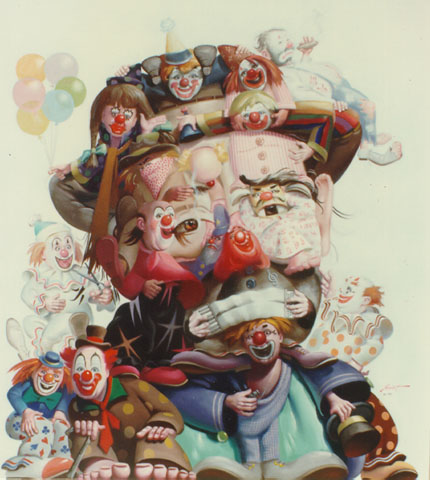Stamp: Clown chantant (France 2017)
Clown chantant (France 2017)
29 September (France ) within release Circus goes into circulation Stamp Clown chantant face value Lettre No Face Value
| Stamp Clown chantant in catalogues | |
|---|---|
| Yvert et Tellier: | Yt: FR A1481 |
| Michel: | Mi: FR 6882 |
Stamp is vertical format.
Permanent validity - Green letter 20g to France - Issued from the booklet: "Circus arts" - Initial value: 0.73€Also in the issue Circus:
- Stamp - Cerceau face value Lettre;
- Stamp - Equilibriste face value Lettre;
- Stamp - Ruban face value Lettre;
- Stamp - Monsieur Loyal face value Lettre;
- Stamp - Lapin face value Lettre;
- Stamp - Dompteur face value Lettre;
- Stamp - Equilibristes face value Lettre;
- Stamp - Clown blanc face value Lettre;
- Stamp - Gymnaste face value Lettre;
- Stamp - Elephant face value Lettre;
- Booklet - Circus face value 12*Lettre;
- Stamp - Equilibriste cheval face value Lettre;
- Stamp - Clown chantant face value Lettre;
Stamp Clown chantant it reflects the thematic directions:
A circus is a company of performers who put on diverse entertainment shows that may include clowns, acrobats, trained animals, trapeze acts, musicians, dancers, hoopers, tightrope walkers, jugglers, magicians, ventriloquists, and unicyclists as well as other object manipulation and stunt-oriented artists. The term circus also describes the field of performance, training and community which has followed various formats through its 250-year modern history. Although not the inventor of the medium, Newcastle-under-Lyme born Philip Astley is credited as the father of the modern circus.
A clown is a person who performs comedy and arts in a state of open-mindedness using physical comedy, typically while wearing distinct makeup or costuming and reversing folkway-norms. The art of performing as a clown is known as clowning or buffoonery, and the term "clown" may be used synonymously with predecessors like jester, buffoon, joker, fool, or harlequin. Clowns have a diverse tradition with significant variations in costume and performance. The most recognisable clowns are those that commonly perform in the circus, characterized by colorful wigs, red noses, and oversized shoes. However, clowns have also played roles in theater and folklore, like the court jesters of the Middle Ages and the jesters and ritual clowns of various indigenous cultures. Their performances can elicit a range of emotions, from humor and laughter to fear and discomfort, reflecting complex societal and psychological dimensions. Through the centuries, clowns have continued to play significant roles in society, evolving alongside changing cultural norms and artistic expressions.
Music is an art form and cultural activity whose medium is sound organized in time. The common elements of music are pitch (which governs melody and harmony), rhythm (and its associated concepts tempo, meter, and articulation), dynamics (loudness and softness), and the sonic qualities of timbre and texture (which are sometimes termed the "color" of a musical sound). Different styles or types of music may emphasize, de-emphasize or omit some of these elements. Music is performed with a vast range of instruments and vocal techniques ranging from singing to rapping; there are solely instrumental pieces, solely vocal pieces (such as songs without instrumental accompaniment) and pieces that combine singing and instruments. The word derives from Greek μουσική (mousike; "art of the Muses"). In its most general form, the activities describing music as an art form or cultural activity include the creation of works of music (songs, tunes, symphonies, and so on), the criticism of music, the study of the history of music, and the aesthetic examination of music. Ancient Greek and Indian philosophers defined music as tones ordered horizontally as melodies and vertically as harmonies. Common sayings such as "the harmony of the spheres" and "it is music to my ears" point to the notion that music is often ordered and pleasant to listen to.
A musical instrument is a device created or adapted to make musical sounds. In principle, any object that produces sound can be considered a musical instrument—it is through purpose that the object becomes a musical instrument. A person who plays a musical instrument is known as an instrumentalist. The history of musical instruments dates to the beginnings of human culture. Early musical instruments may have been used for rituals, such as a horn to signal success on the hunt, or a drum in a religious ceremony. Cultures eventually developed composition and performance of melodies for entertainment. Musical instruments evolved in step with changing applications and technologies.
A musician is an artist who composes, conducts, or performs music. According to the United States Employment Service, "musician" is a general term used to designate a person who follows music as a profession. Musicians include songwriters, who write both music and lyrics for songs; conductors, who direct a musical performance; and performers, who perform for an audience. A music performer is generally either a singer, who provides vocals, or an instrumentalist, who plays a musical instrument. Musicians may perform on their own or as part of a group, band or orchestra. Musicians can specialize in a musical genre, though many play a variety of different styles, depending on the cultures and backgrounds involved. A musician who records and releases music can be known as a recording artist.




